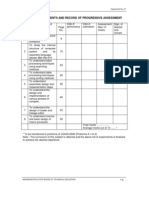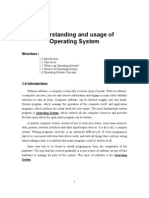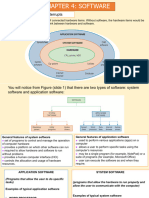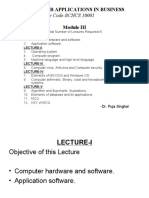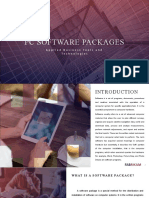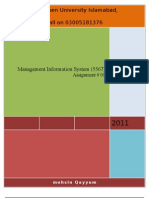0 ratings0% found this document useful (0 votes)
109 viewsConceptual Framework - Software-1
Conceptual Framework - Software-1
Uploaded by
Mitesh KumarThe document provides an overview of different types of software, including application software, system software, compilers, assemblers, interpreters, and operating systems. It discusses the main features and functions of each type of software. The key topics covered include the differences between application and system software, how compilers, assemblers, and interpreters translate programming code, and the main roles and classifications of operating systems.
Copyright:
© All Rights Reserved
Available Formats
Download as PPTX, PDF, TXT or read online from Scribd
Conceptual Framework - Software-1
Conceptual Framework - Software-1
Uploaded by
Mitesh Kumar0 ratings0% found this document useful (0 votes)
109 views20 pagesThe document provides an overview of different types of software, including application software, system software, compilers, assemblers, interpreters, and operating systems. It discusses the main features and functions of each type of software. The key topics covered include the differences between application and system software, how compilers, assemblers, and interpreters translate programming code, and the main roles and classifications of operating systems.
Original Description:
co
Copyright
© © All Rights Reserved
Available Formats
PPTX, PDF, TXT or read online from Scribd
Share this document
Did you find this document useful?
Is this content inappropriate?
The document provides an overview of different types of software, including application software, system software, compilers, assemblers, interpreters, and operating systems. It discusses the main features and functions of each type of software. The key topics covered include the differences between application and system software, how compilers, assemblers, and interpreters translate programming code, and the main roles and classifications of operating systems.
Copyright:
© All Rights Reserved
Available Formats
Download as PPTX, PDF, TXT or read online from Scribd
Download as pptx, pdf, or txt
0 ratings0% found this document useful (0 votes)
109 views20 pagesConceptual Framework - Software-1
Conceptual Framework - Software-1
Uploaded by
Mitesh KumarThe document provides an overview of different types of software, including application software, system software, compilers, assemblers, interpreters, and operating systems. It discusses the main features and functions of each type of software. The key topics covered include the differences between application and system software, how compilers, assemblers, and interpreters translate programming code, and the main roles and classifications of operating systems.
Copyright:
© All Rights Reserved
Available Formats
Download as PPTX, PDF, TXT or read online from Scribd
Download as pptx, pdf, or txt
You are on page 1of 20
Conceptual
Framework
Unit 1
Computer Application and Management Information System; NMBA 018 1
Topics to cover:
Software
Types of Software
Application Software
System Software
Compiler
Assembler
Interpreter
Operating System
Functions, Types and Classification
Elements of GUI based operating system
Computer Application and
Management Information System;
NMBA 018 2
What is Software?
part of acomputer systemthat consists of
encoded information or computer
instructions, in contrast to the
physicalhardwarefrom which the system is
built
Computer Application and
Management Information System;
NMBA 018 3
Types of Software
System Software
Application Software
Computer Application and
Management Information System;
NMBA 018 4
System Software
collection of programs designed to operate,
control, and extend the processing
capabilities of the computer itself
are generally prepared by computer
manufactures
comprise of programs written in low-level
languages which interact with the hardware
at a very basic level
serves as the interface between hardware
and the end users
Computer Application and
Management Information System;
NMBA 018 5
Examples of System
Software
Operating System,
Compilers,
Interpreter,
Assemblers etc.
Computer Application and
Management Information System;
NMBA 018 6
Features of System
Software
Close to system
Fast in speed
Difficult to design
Difficult to understand
Less interactive
Smaller in size
Difficult to manipulate
Generally written in low-level language
Computer Application and
Management Information System;
NMBA 018 7
Application Software
designed to satisfy a particular need of a particular
environment.
All software applications prepared in the computer
lab can come under the category of Application
software.
may consist of a single program, such as a
Microsoft's notepad for writing and editing simple
text
or may consist of a collection of programs, often
called a software package, which work together to
accomplish a task, such as a spreadsheet package.
Computer Application and
Management Information System;
NMBA 018 8
Examples of Application
software are following:
Payroll Software
Student Record Software
Inventory Management Software
Income Tax Software
Railways Reservation Software
Microsoft Office Suite Software
Microsoft Word
Microsoft Excel
Microsoft Powerpoint
Computer Application and
Management Information System;
NMBA 018 9
Features of Application
Software
Close to user
Easy to design
More interactive
Slow in speed
Generally written in high-level language
Easy to understand
Easy to manipulate and use
Bigger in size and requires large storage
space
Computer Application and
Management Information System;
NMBA 018 10
Assembler
program which translates an assembly
language program into a machine language
program
If an assembler which runs on a computer
and produces the machine codes for the
same computer then it is called self
assembler or resident assembler.
If an assembler that runs on a computer
and produces the machine codes for other
computer then it is called Cross Assembler.
Computer Application and
Management Information System;
NMBA 018 11
Types of Assembler
One Pass Assembler
assigns the memory addresses to the variables
and translates the source code into machine code
in the first pass simultaneously.
Two Pass Assembler
reads the source code twice.
In the first pass, it reads all the variables
and assigns them memory addresses.
In the second pass, it reads the source code
and translates the code into object code.
Computer Application and
Management Information System;
NMBA 018 12
Compiler
program which translates a high level
language program into a machine language
program
If a compiler runs on a computer and produces
the machine codes for the same computer
then it is known as a self compiler or resident
compiler.
If a compiler runs on a computer and produces
the machine codes for other computer then it
is known as a cross compiler.
Computer Application and
Management Information System;
NMBA 018 13
Advantages and Disadvantages
of Compiler
Advantages
is more intelligent than an assembler
checks all kinds of limits, ranges, errors etc.
Disadvantages
More program run time
Occupies a larger part of the memory
Slow speed.
Computer Application and
Management Information System;
NMBA 018 14
Interpreter
A program which translates statements of a
program into machine code
translates only one statement of the
program at a time
reads only one statement of program,
translates it and executes it. Then it reads
the next statement of the program again
translates it and executes it
Computer Application and
Management Information System;
NMBA 018 15
Compiler v/s Interpreter
A compiler is 5 to 25 times faster than an
interpreter.
Compiler saves the machine codes
permanently for future reference.
Interpreter does not save the machine codes
produced
An interpreter is a small program as compared
to compiler.
Interpreter occupies less memory space, so it
can be used in a smaller system which has
limited memory space
Computer Application and
Management Information System;
NMBA 018 16
Operating Systems
A program that acts as an interface
between the user and the computer
hardware and controls the execution of all
kinds of programs.
performs all the basic tasks like file
management, memory management,
process management, handling input and
output, and controlling peripheral devices
such as disk drives and printers.
Computer Application and
Management Information System;
NMBA 018 17
Operating System
Computer Application and
Management Information System;
NMBA 018 18
Functions of Operating
System
Memory Management
Processor Management
Device Management
File Management
Security
Control over system performance
Job accounting
Error detecting aids
Coordination between other software and
users
Computer Application and
Management Information System;
NMBA 018 19
Types of Operating System
Batch Operating Systems
Time Sharing Operating System
Distributed Operating System
Network Operating System
Real Time Operating System
Computer Application and
Management Information System;
NMBA 018 20
You might also like
- New Chapter 3 Programming CDocument13 pagesNew Chapter 3 Programming CAmzar ShukriNo ratings yet
- Case Study On MISDocument3 pagesCase Study On MISsolocheruic100% (1)
- MIS As A Communication ProcessDocument12 pagesMIS As A Communication ProcessVinutha SanthoshNo ratings yet
- ISO Assignment QP Spring Winter 2021 20 Credit FINALDocument5 pagesISO Assignment QP Spring Winter 2021 20 Credit FINALApanar OoNo ratings yet
- Chapter 1 Part 1Document5 pagesChapter 1 Part 1girlfatherless1No ratings yet
- SS Lession NotesDocument37 pagesSS Lession Notesabinavabi1806No ratings yet
- Unit 3Document15 pagesUnit 3ankitarana0909No ratings yet
- List of Experiments and Record of Progressive Assessment: Date of Performance Date of SubmissionDocument37 pagesList of Experiments and Record of Progressive Assessment: Date of Performance Date of SubmissionIqbal HassanNo ratings yet
- PSC - Doc - 2017 - 12 PDFDocument119 pagesPSC - Doc - 2017 - 12 PDFSunil Kumar VemulaNo ratings yet
- Unit 1 Spos Notes - DocxDocument24 pagesUnit 1 Spos Notes - DocxSrushti GhiseNo ratings yet
- SSMOD1Document12 pagesSSMOD1Aвнιѕнєк SVNo ratings yet
- Operating SystemDocument119 pagesOperating Systemapi-3800943100% (1)
- PSC - Common Lecture Notes-1Document119 pagesPSC - Common Lecture Notes-1srikanth100% (1)
- Lecture 04Document24 pagesLecture 04Ayman PirzadaNo ratings yet
- 80 ReviewerDocument3 pages80 ReviewerRyanNo ratings yet
- CF - Unit 2 PDFDocument80 pagesCF - Unit 2 PDFBrindaNo ratings yet
- CSC520-ch1 IntroductionDocument46 pagesCSC520-ch1 IntroductionSyed Nur Muhammad Al-Bukhary Bin Syed HassanNo ratings yet
- Chapter 4 SoftwareDocument15 pagesChapter 4 Softwarea2080903768No ratings yet
- DCS 213Document22 pagesDCS 213zakariyaabdullahi305No ratings yet
- Software Notes 1 SwanDocument3 pagesSoftware Notes 1 Swansally hakutangwiNo ratings yet
- softwareDocument2 pagessoftwarestellar.dotsNo ratings yet
- Introduction To System SoftwareDocument18 pagesIntroduction To System Softwareyani_06No ratings yet
- Unit 2 Two marks Ques - with answersDocument4 pagesUnit 2 Two marks Ques - with answersarjunsaicbe18No ratings yet
- IT For Managers - Block2 2Document36 pagesIT For Managers - Block2 2Patel RahulNo ratings yet
- SS MaterialDocument105 pagesSS MaterialCS-18 Harshil JaganiNo ratings yet
- Operating SystemsDocument105 pagesOperating SystemsMahela DissanayakeNo ratings yet
- Computer SoftwareDocument11 pagesComputer Softwaregeorgessenfuma813No ratings yet
- 1 - Overview of System SoftwareDocument5 pages1 - Overview of System SoftwareNikhil ChhillarNo ratings yet
- C LanguageDocument119 pagesC LanguageNALLAPERUMAL MNo ratings yet
- AS Level IT Chapter 2 - Hardware and Software Flashcards - QuizletDocument66 pagesAS Level IT Chapter 2 - Hardware and Software Flashcards - QuizletabiyyaNo ratings yet
- Mod 1Document4 pagesMod 1sreetemp10No ratings yet
- SoftwareDocument7 pagesSoftwareManas AgarwalNo ratings yet
- Programming C 1.3Document8 pagesProgramming C 1.3asif11freeNo ratings yet
- ComputerDocument3 pagesComputerBikash Kumar BeheraNo ratings yet
- Complete Download Darshan InstitutE of Technology SEM 5 INDUS UNIVERSITY AHMEDABAD SP CSE Ssssss PDF All ChaptersDocument52 pagesComplete Download Darshan InstitutE of Technology SEM 5 INDUS UNIVERSITY AHMEDABAD SP CSE Ssssss PDF All Chaptersladanprang100% (4)
- Computer - SoftwareDocument11 pagesComputer - SoftwareBikal ShresthaNo ratings yet
- Chapter 1Document7 pagesChapter 1V KumarNo ratings yet
- Operating System: Operating Systems: Internals and Design PrinciplesDocument81 pagesOperating System: Operating Systems: Internals and Design PrinciplesRamadan ElhendawyNo ratings yet
- Module 1-Part 1Document21 pagesModule 1-Part 1vidhya_bineeshNo ratings yet
- Instant Download Darshan InstitutE of Technology SEM 5 INDUS UNIVERSITY AHMEDABAD SP CSE Ssssss PDF All ChaptersDocument65 pagesInstant Download Darshan InstitutE of Technology SEM 5 INDUS UNIVERSITY AHMEDABAD SP CSE Ssssss PDF All Chaptersoletanohel7v100% (2)
- Computer - Module 3Document72 pagesComputer - Module 3ushalatasharmaNo ratings yet
- Lecture 4Document57 pagesLecture 4pariyal malikNo ratings yet
- Operating System 1.1Document14 pagesOperating System 1.1Partho Pratim SealNo ratings yet
- MIS Lesson 4 - SoftwareDocument42 pagesMIS Lesson 4 - SoftwareMaria Mina RazonNo ratings yet
- Information Technology Unit I. 1.1 Introduction To ComputersDocument122 pagesInformation Technology Unit I. 1.1 Introduction To Computersveere_arunNo ratings yet
- System Software: Operating Systems and Utility ProgramsDocument50 pagesSystem Software: Operating Systems and Utility ProgramstayweidaNo ratings yet
- Operating SystemsDocument48 pagesOperating Systemsdetel74956No ratings yet
- Unit - 1: What Is Software?Document32 pagesUnit - 1: What Is Software?Syed OsamaNo ratings yet
- Compiler Design Mini Project Shivang PDFDocument7 pagesCompiler Design Mini Project Shivang PDF12C 04 Sakshi GuptaNo ratings yet
- Applied Business Tools 2Document25 pagesApplied Business Tools 2Kirby Miranda100% (1)
- Introduction To Computer System: SoftwareDocument22 pagesIntroduction To Computer System: SoftwaremilkesomidaksaNo ratings yet
- Ms Unit 4Document3 pagesMs Unit 4haulath2020No ratings yet
- Introduction To ProgrammingDocument17 pagesIntroduction To ProgrammingVarun AroraNo ratings yet
- DCA6101-Unit 12-Operating System ConceptsDocument19 pagesDCA6101-Unit 12-Operating System ConceptsJust SaaNo ratings yet
- Application and System Software: Course: BCA Subject: Fundamental of Computer Unit: 2Document38 pagesApplication and System Software: Course: BCA Subject: Fundamental of Computer Unit: 2Yogesh KuteNo ratings yet
- IICT Lecture # 09 Softwars Its TypesDocument39 pagesIICT Lecture # 09 Softwars Its Typesvideolytical607No ratings yet
- Domain 08 - Software Development SecurityDocument123 pagesDomain 08 - Software Development SecurityCSK100% (1)
- Week 03Document51 pagesWeek 03uchihakakashi133640No ratings yet
- CSC 111 - Introduction To Computer Science Part2Document26 pagesCSC 111 - Introduction To Computer Science Part2addisondre6No ratings yet
- Computer Science: Learn about Algorithms, Cybersecurity, Databases, Operating Systems, and Web DesignFrom EverandComputer Science: Learn about Algorithms, Cybersecurity, Databases, Operating Systems, and Web DesignNo ratings yet
- "Unleashing the Power of Assembly Language: Mastering the World's Most Efficient Code"From Everand"Unleashing the Power of Assembly Language: Mastering the World's Most Efficient Code"No ratings yet
- Software Suite: Revolutionizing Computer Vision with the Ultimate Software SuiteFrom EverandSoftware Suite: Revolutionizing Computer Vision with the Ultimate Software SuiteNo ratings yet
- Amazon has finally unveiled its physical store to the public. अअअअअ अअ ,Document2 pagesAmazon has finally unveiled its physical store to the public. अअअअअ अअ ,Mitesh KumarNo ratings yet
- Application For DiwaliDocument1 pageApplication For DiwaliMitesh KumarNo ratings yet
- Personality TestDocument15 pagesPersonality TestMitesh Kumar100% (1)
- Validity of Measurement ScaleDocument14 pagesValidity of Measurement ScaleMitesh KumarNo ratings yet
- Personality TestDocument15 pagesPersonality TestMitesh KumarNo ratings yet
- Nature of Capital Budgeting & Types of Capital ProjectsDocument11 pagesNature of Capital Budgeting & Types of Capital ProjectsMitesh KumarNo ratings yet
- Personality TestDocument15 pagesPersonality TestMitesh Kumar100% (1)
- Types of DividendsDocument7 pagesTypes of DividendsMitesh KumarNo ratings yet
- Nature of Capital Budgeting & Types of Capital ProjectsDocument11 pagesNature of Capital Budgeting & Types of Capital ProjectsMitesh KumarNo ratings yet
- Nature of Capital Budgeting & Types of Capital ProjectsDocument11 pagesNature of Capital Budgeting & Types of Capital ProjectsMitesh KumarNo ratings yet
- Nature of Capital Budgeting & Types of Capital ProjectsDocument11 pagesNature of Capital Budgeting & Types of Capital ProjectsMitesh KumarNo ratings yet
- HR Interview For FreshersDocument1 pageHR Interview For FreshersMitesh KumarNo ratings yet
- Nature of Capital Budgeting & Types of Capital ProjectsDocument11 pagesNature of Capital Budgeting & Types of Capital ProjectsMitesh KumarNo ratings yet
- Information System For ManagersDocument117 pagesInformation System For Managerssushainkapoor photoNo ratings yet
- BUAD 822 Note-MIS-ICT ManagementDocument306 pagesBUAD 822 Note-MIS-ICT ManagementZainab Ibrahim100% (1)
- Module 2 The Accounting Information SystemsDocument49 pagesModule 2 The Accounting Information SystemsMaricar PinedaNo ratings yet
- 7 MisDocument22 pages7 MismikeNo ratings yet
- SADDocument32 pagesSADnejuwayNo ratings yet
- Your Results For - Multiple ChoiceDocument2 pagesYour Results For - Multiple ChoiceMrinaalini SelvarajanNo ratings yet
- IT Jobs at IMF - 10-2020 PDFDocument33 pagesIT Jobs at IMF - 10-2020 PDFedeNo ratings yet
- Real Role of MisDocument18 pagesReal Role of MisJimoh OghoghoameNo ratings yet
- STE Computer Programming Types of Information System Q1 MODULE 3Document17 pagesSTE Computer Programming Types of Information System Q1 MODULE 3Rosarie CharishNo ratings yet
- Front Desk Information SystemDocument57 pagesFront Desk Information SystemGen MasopeNo ratings yet
- Chapter 6 - Strategic ControlDocument21 pagesChapter 6 - Strategic ControlArslan SaleemNo ratings yet
- Global E-Business and CollaborationDocument8 pagesGlobal E-Business and CollaborationkapilNo ratings yet
- AE 20 Prelim ExamDocument3 pagesAE 20 Prelim ExamRizz Aigel OrillosNo ratings yet
- Eoi FGDocument17 pagesEoi FGBirhanu AtnafuNo ratings yet
- Case Study Assignment (Part 2)Document3 pagesCase Study Assignment (Part 2)Joey LebenNo ratings yet
- Network Modeling: The Chapter Will Address The Following QuestionsDocument41 pagesNetwork Modeling: The Chapter Will Address The Following Questionstunali21321No ratings yet
- IPT Project ManagementDocument29 pagesIPT Project ManagementAustin VuongNo ratings yet
- Emerging Trends in IS and Tecnology-Project-Work-2023Document19 pagesEmerging Trends in IS and Tecnology-Project-Work-2023Larry KnNo ratings yet
- O O O O O: Msc. Applied Mathematics, Msc. Information Systems Engineering, Bsc. HonsDocument21 pagesO O O O O: Msc. Applied Mathematics, Msc. Information Systems Engineering, Bsc. HonsKimeu EstherNo ratings yet
- Hospital Management SystemDocument12 pagesHospital Management SystemSingh Vadan0% (1)
- KMC Course Plan ITC 206 E-Commerce 2078 (2022)Document3 pagesKMC Course Plan ITC 206 E-Commerce 2078 (2022)Uttam KarkiNo ratings yet
- Enhanced The Coca Cola Business in Pakistan Through The Usage of Management Information System - CCBPLDocument27 pagesEnhanced The Coca Cola Business in Pakistan Through The Usage of Management Information System - CCBPLAtiffarooq KingNo ratings yet
- 5567 - MIS - Assignment # 1Document31 pages5567 - MIS - Assignment # 1umer bin abid100% (2)
- Management Information System PDFDocument6 pagesManagement Information System PDFHashim HabeedNo ratings yet
- Mrsptu PG Open Electives-I 2016 Batch Onwards Updated On 21.2.2018Document29 pagesMrsptu PG Open Electives-I 2016 Batch Onwards Updated On 21.2.2018Mithilesh VermaNo ratings yet
- Nursing Informatics 1Document38 pagesNursing Informatics 1Erika Mae RevadiloNo ratings yet
- Arizona Baseline Security ControlsDocument881 pagesArizona Baseline Security ControlsAnkit ShekharNo ratings yet







